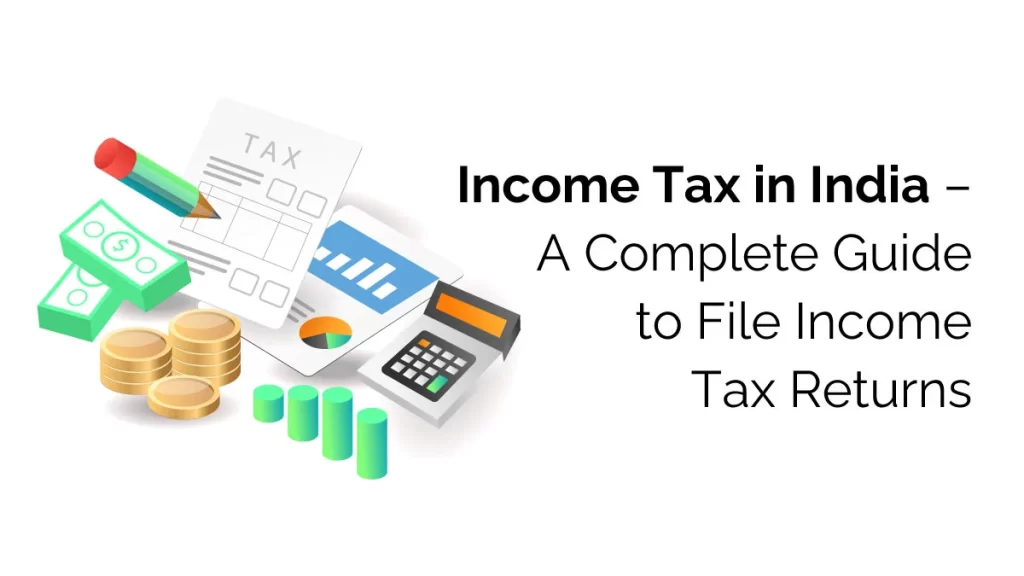Have you ever thought about how the Government gets money? Governments collect revenue in various ways, but one standard method is taxes. One significant type of tax is income tax, which is imposed on the earnings of individuals and corporations within a given fiscal year. The funds raised through income tax support various government programs such as healthcare, education, infrastructure development, and social welfare initiatives such as farm subsidies.
There are two types of taxes – direct taxes and indirect taxes. Direct taxes are levied on the income earned directly by an individual or corporation, while indirect taxes are levied on goods and services. An instance of a direct tax is income tax. The income tax an individual or corporation must pay is determined by their income bracket and the applicable tax rates for that fiscal year. The tax calculation is based on income slab rates determined by the government and is subject to change from year to year.
Rules of Income Tax in India
The legislature enacted the Income Tax Act of 1961 to govern and regulate income tax in the country. Subsequently, in 1962, the Income Tax Rules were established to facilitate the implementation and enforcement of the Act. The Income tax rules are formulated within the scope of the Income Tax Act and are obligated to comply with its requirements. It is essential to note that the Income-tax rules must be read with the Income tax act and cannot override its provisions.
Taxpayers
Any Indian individual below the age of 60 years earning an annual income exceeding Rs 2.5 lakh is liable to pay income tax to the Government of India. Similarly, individuals aged 60 and above making more than Rs 2.5 lakh per annum must also pay taxes.
Under the Indian income tax regulations, taxpayers are classified into various categories, including Individuals, Association of Persons (AOP), Hindu Undivided Families (HUF), and Body of Individuals (BOI), each with a different tax structure based on their income slab. On the other hand, businesses and Indian companies are taxed based on their taxable profits at a fixed rate.
The taxable income of an individual is classified into different tax slabs or brackets, each with varying tax rates. The tax rates increase proportionately to the income slab, i.e., as the income slab rises, so does the tax rate.
Income tax criteria
In India, all individuals who earn or receive income must pay income tax regardless of whether they are residents or non-residents. The Revenue Tax Department has divided income into five primary categories to simplify the classification process.
The first category includes income earned from renting a residence, subject to taxation.
And the second category comprises salary and pension income, which is also taxable.
The third category involves profits earned by self-employed individuals, businesses, freelancers, or contractors and income made by professionals such as chartered accountants, life insurance agents, doctors, lawyers, and tuition teachers who run their practices.
The fourth category pertains to mutual funds, stocks, or real estate, which is also taxable.
The fifth and final category encompasses income from interest earned on savings bank accounts, fixed deposits, and winnings from lotteries, which is taxable as well.
How to calculate Income tax?
Individuals need to calculate their income tax based on the nature of their earnings. For instance, salary earners may utilize the available exclusions for various allowances.
Individuals and Hindu Undivided Families (HUFs) can claim deductions under Sections 80C through 80U. They can then subtract the conclusions from their total gross income to compute their income tax due.
Additionally, the taxpayer should adjust their total income tax liability for taxes already paid, such as advance Tax, Tax Deducted at Source (TDS), etc. The taxpayer should also take into account any rebates available under Section 87A and relief available under Sections 89, 90, and relief available under Sections 89, 90, and 91. By doing so, the taxpayer can determine the net amount of income tax payable.
It is important to note that every source of income should be reported on the tax return. However, the legislation exempts some payments, such as dividend income from an Indian company and Long-Term Capital Gains (LTCG) on listed equity shares up to Rs 1 lakh in any financial year.
To calculate the taxes payable on your income, follow these quick steps:
- Compile a list of all your earnings, including salary, rental income, interest income, capital gains, and profits from your business or profession.
- Remove any legally exempt income.
- Claim all eligible deductions for each source of income. For instance, if you have a salary income, you can claim a standard deduction of Rs. 50,000. Regarding rental revenue, you can claim deductions for municipal taxes and repairs and maintenance expenses.
- You can avail eligible deductions from your overall income under different sections of the Income Tax Act. For example, Section 80C allows deductions for investments in specified instruments like Employee Provident Fund (EPF), Public Provident Fund (PPF), Life Insurance Premiums, and Equity-Linked Savings Scheme (ELSS).
- Once you have calculated your taxable income, check your tax bracket and calculate your income tax liability accordingly.
By following these steps, you can quickly calculate the taxes payable on your income.
Steps on How to file income tax returns online?
You can file your ITR (Income Tax Return) online using either the income tax e-filing portal or through third-party platforms. If you file through the government portal, you can use the “offline” or “online” mode.
To file through the offline mode, visit https://www.incometax.gov.in/iec/foportal/ and download the Excel or Java utilities of the applicable ITR form from the “Download” tab under “ITR Return Preparation Software.” After extracting the ZIP file, fill in all the relevant fields in the utility and validate all the sheets before clicking on “Calculate Tax.” Afterwards, choose one of the six verification options available and submit the form. Once complete, generate and save the XML utility, which can be uploaded on the portal for e-filing.
To file through the online mode:
- Access the e-filing portal by entering your PAN, password, and captcha details.
- Navigate to the “e-file” tab and open the “Income Tax Return” link from the dropdown menu.
- Fill in the required details and select “Prepare and Submit Online” as the submission mode.
- Complete the ITR form opened online and save it as a draft by clicking on “Save as Draft.”
- Verify the return using Aadhaar OTP/EVC or send a physical copy to the Centralized Processing Centre (CPC).
- Submit the return.
Joining an Income tax course allows learners to know more about filing income tax. The online Income Tax accounting course offers an excellent opportunity for learners to understand the subject comprehensively. Finprov provides an Income Tax course aimed at equipping learners with the essential knowledge and skills needed for accurate and efficient preparation and filing of income tax returns. Our Income Tax course covers fundamental concepts, including the significant heads of income, tax frameworks, old and new tax schemes, basics of TDS & TCS, due dates, penalties, accounting books, and accounting maintenance. Practical training is provided at the end of each topic, which helps learners gain valuable experience and better grasp the concepts.





